Dear Aspirants, Our IBPS Guide team is providing new series of Reasoning Questions for IBPS Clerk Prelims 2019 so the aspirants can practice it on a daily basis. These questions are framed by our skilled experts after understanding your needs thoroughly. Aspirants can practice these new series questions daily to familiarize with the exact exam pattern and make your preparation effective.
[WpProQuiz 7425]
Ensure Your Ability Before of Exam – Take IBPS Clerk Prelims Free Mock test
Puzzle
Directions (1-5): Study the following information carefully to answer the given question:
Eight boxes F, G, H, U, V, X, Y and Z are placed one above another. Only two boxes are placed between box U and X. Box G is placed immediately above box V. Three boxes are placed between G and Z. Only one box is placed between box U and F. Not more than one box is placed between box F and Y. Box H is placed below box Y. Box Z is neither placed at top nor above box Y. Box X is not placed at the bottom.
1) Which of the following box is kept at the top?
a) V
b) F
c) U
d) X
e) None of these
2) Which of the following box is placed immediately above box H?
a) V
b) G
c) U
d) X
e) None of these
3) How many boxes are kept between box G and box Y?
a) One
b) Three
c) Two
d) Four
e) None of these
4) How many boxes are kept below box V?
a) Three
b) Two
c) One
d) More than Three
e) None
5) Which of the following box is placed immediately below box Y?
a) V
b) F
c) U
d) X
e) None of these
Seating Arrangement
Directions (6-10): Study the following information carefully to answer the given question:
Eight persons P, Q, R, S, T, U, V and W are sitting around a square table. Four of them are sitting at the corners and faces outside the centre while four are sitting at the middle side of the table and faces inside the table. Only one person sit between U and P. S sits immediate right of V neither of them is an immediate neighbour of U and P. Q sits second to the right of S. W sits second to the left of R and both of them sit at the corners of the table. R is not an immediate neighbour of S. T neither sit on the middle side of the table nor sit opposite to R. U is not an immediate neighbour of T.
6) Who among the following faces P?
a) W
b) S
c) R
d) V
e) None of these
7) Four of the following are alike in a certain way so form a group which of the following does not belong to that group?
a) S
b) P
c) V
d) Q
e) U
8) Which of the following is true regarding R?
a) Two persons sits between R and Q
b) R sits second to the right of T.
c) R is an immediate neighbour of Q.
d) R is an immediate neighbour of the one who sit opposite to P.
e) Only two persons sit between R and V
9) What is the position of V with respect to W?
a) Second to the left
b) Third to the left
c) Immediate right
d) Immediate left
e) Second to the right
10) What is the position of S with respect to Q?
a) Third to the left
b) Second to the left
c) Forth to the left
d) Third to the right
e) Fifth to the right
Answers :
Directions (1-5):
Box G is placed immediately above box V. Three boxes are placed between G and Z.

Only two boxes are placed between box U and X. Only one box is placed between box U and F.
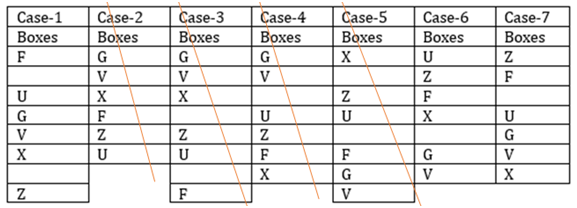
Not more than one box is placed between box F and Y. Box H is placed below box Y. From this case-2, 3, 4 and 5 gets eliminated. Box X is not placed at the bottom.
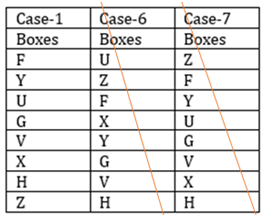
Box Z is neither placed at top nor above box Y. So that case-6 and 7 gets eliminated and final arrangement is-
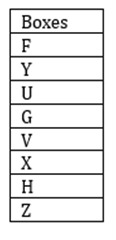
1) Answer: B
2) Answer: D
3) Answer: A
4) Answer: A
5) Answer: C
Directions (6-10):
Only one person sit between U and P. S sits immediate right of V neither of them is an immediate neighbour of U and P. Q sits second to the right of S.
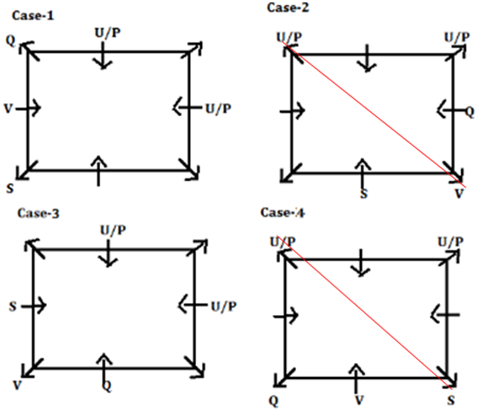
W sits second to the left of R and both of them sit at the corners of the table. R is not an immediate neighbour of S. So, from this case-2 and 4 will get eliminated.
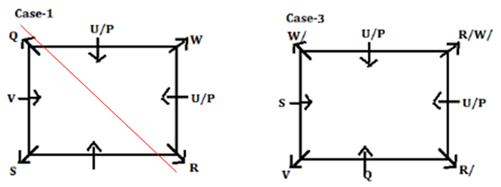
T neither sits on the middle side of the table nor is sitting opposite to R. U not an immediate neighbour of T. So, from this case-1 gets eliminated. And the final arrangement is—-
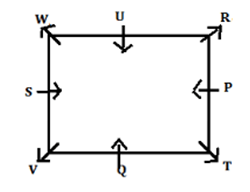
6) Answer: B
7) Answer: C
8) Answer: A
9) Answer: A
10) Answer: B






